Data Analytics, Data Science Degrees See Large Increases in 2022
Statistics Master’s Degrees Drop 15 Percent
Steve Pierson, ASA Director of Science Policy
This fall’s release of the 2022 degree completion data from the National Center for Education Statistics is marked by the large increases in the undergraduate and master’s degrees awarded in the recently introduced categories for data analytics and data science. The number of bachelor’s degrees in data science, for example, jumped to 897 in 2022, from 165 in 2021 and 84 in 2020. For bachelor’s degrees in data analytics, the 2020, 2021, and 2022 numbers are 325, 455, and 767, respectively. The number of bachelor’s degrees in statistics also grew, albeit more modestly than in prior years: 5,408 in 2022, a 2 percent increase over 2021, as shown in Figure 1. A 15 percent drop in the number of master’s degrees in statistics to 3,570 in 2022, also observed in that figure, stood out in the most recent release as well.
Departments contacted by the ASA about the drop in master’s degrees awarded in 2022 by their departments (relative to 2021) attributed the decline generally to drops in applications and enrollment due to the pandemic. We also heard of declining interest from Chinese students due to changing job opportunities and work visa availability. The introduction of closely related degree programs was also suggested as a possible reason for the drop in master’s degrees in statistics.
Master’s degrees in biostatistics awarded in 2022 held steady at 916, compared with 917 in 2021, while PhDs in biostatistics increased from 222 in 2021 to 272 in 2022, surpassing 250 for the first time (Figure 2). The large increase in PhDs is largely attributable to pandemic delays and was observed across STEM fields. PhDs in statistics increased from 467 to 539 for that period. Focusing on master’s degrees in data science, analytics, and related fields—which the ASA has been tracking for years—the jumps in the two NCES Classification of Instructional Programs (CIP) codes introduced for the 2019–2020 academic year for data science (30.70) and data analytics (30.71) are the most dramatic, each increasing by more than a factor of 4, as shown in Figure 3. The number of universities awarding those degrees more than doubled. See Figure 4 and Table 1.
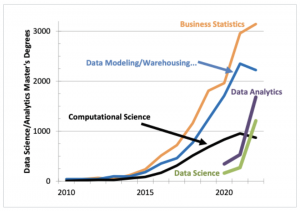
Figure 3: Master’s degrees awarded from 2010–2022 for three CIP categories commonly used by new data science/analytics programs. The graph also shows the number of master’s degrees awarded in 2020, 2021, and 2022 using the new CIP codes for data analytics and data science.
Prior to the introduction of the data science and analytics CIP codes, the ASA used three other CIP codes as a proxy to track the growth of such master’s programs: business statistics; data modeling/warehousing and database administration; and computational science. As also seen in Figure 4, the number of degrees in business statistics grew modestly in 2022, while the other two saw declines, likely for the same reason as for master’s degrees in statistics. As shown in Table 1, however, the number of universities awarding master’s degrees with these three CIP codes increased considerably.
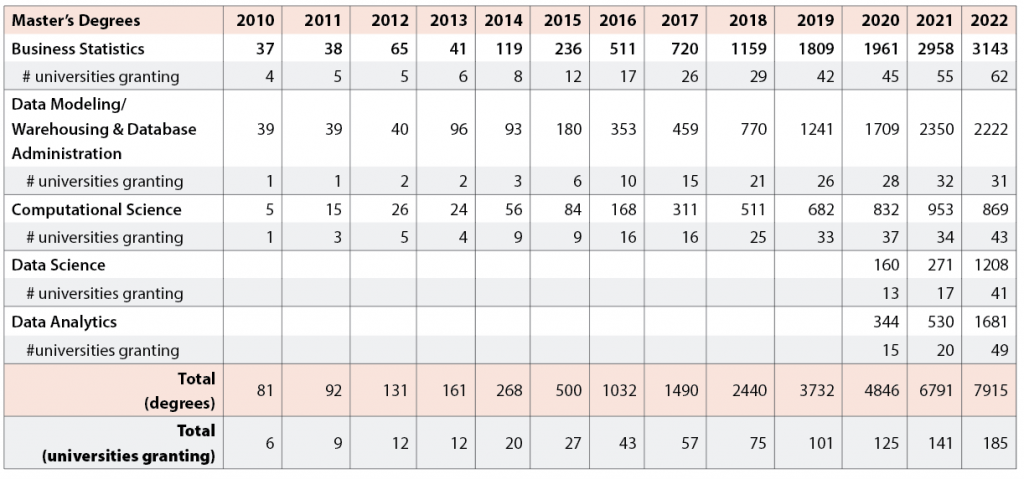
Table 1: Number of Master’s Degrees in Data Science, Analytics, and Related Fields for 2010–2022 and Number of Universities Awarding Them
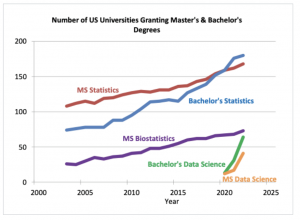
Figure 4: The number of universities granting statistics, biostatistics, and data science master’s and bachelor’s degrees. Compiled from NCES IPEDS data.
As also shown in Figures 4 and 5, the number of universities awarding bachelor’s, master’s, and doctoral degrees in statistics and biostatistics generally increased from 2021 to 2022. The exception is PhDs in statistics, for which the number of universities went from 75 in 2021 to 74 in 2022. Seven universities granted biostatistics degrees at the bachelor’s level in 2022, which is not included in the graphs.
The 2022 NCES completion data release also marked the first conferring of PhDs in data science, 10 from Worcester Polytechnic Institute and three from Kennesaw State University. Kennesaw also conferred PhDs in data analytics in 2020 (7), 2021 (1), and 2022 (2). View lists of universities awarding other degrees covered in this article.
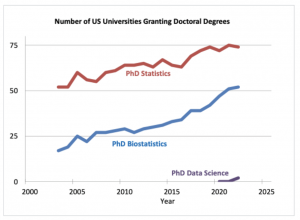
Figure 5: The number of universities granting statistics, biostatistics, and data science PhDs. Compiled from NCES IPEDS data.
The following 15 universities granted statistics and biostatistics degrees for the first time (at least since 2003) in 2022:
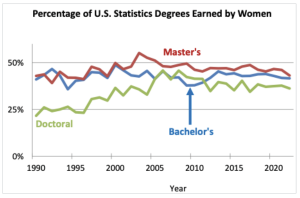
Figure 6: Percentage of statistics degrees awarded to women by degree level for 1990–2022. Data Source: NCES IPED.
For 2020–2021, there were 31 universities awarding such degrees for the first time.
The top degree-granting institutions over the last five years are in tables 2–6 (below) for all categories except biostatistics bachelor’s degrees.
Demographics
Following our practice of alternating demographics updates, this year we look at the breakdown of degrees earned by men and women. Last year’s update, which was based on 2021 degree data, had figures for the percentage of statistics and biostatistics degrees earned by nonresident aliens and race and ethnicity data for the degrees granted to US citizens or residents. The file with the race/ethnicity data at the URL above has been updated with the 2022 data.
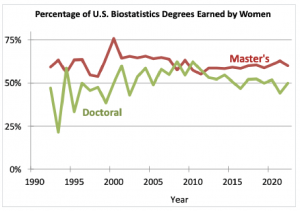
Figure 7: Percentage of master’s and PhD biostatistics degrees awarded to women for 1992–2022. Data Source: NCES IPED.
Figures 6–7 show the percentage of degrees earned by women over time by degree level for statistics and biostatistics. The percentage of women earning biostatistics master’s degrees is around 60 percent and 50% for PhDs. The percentage of statistics PhDs earned by women has been 36–37 percent the last several years. For bachelor’s and master’s degrees in statistics, the percentage is 42–43 percent for 2022.
View these and related data, including the universities awarding master’s degrees in business statistics.

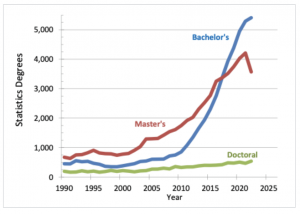
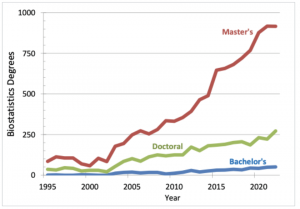
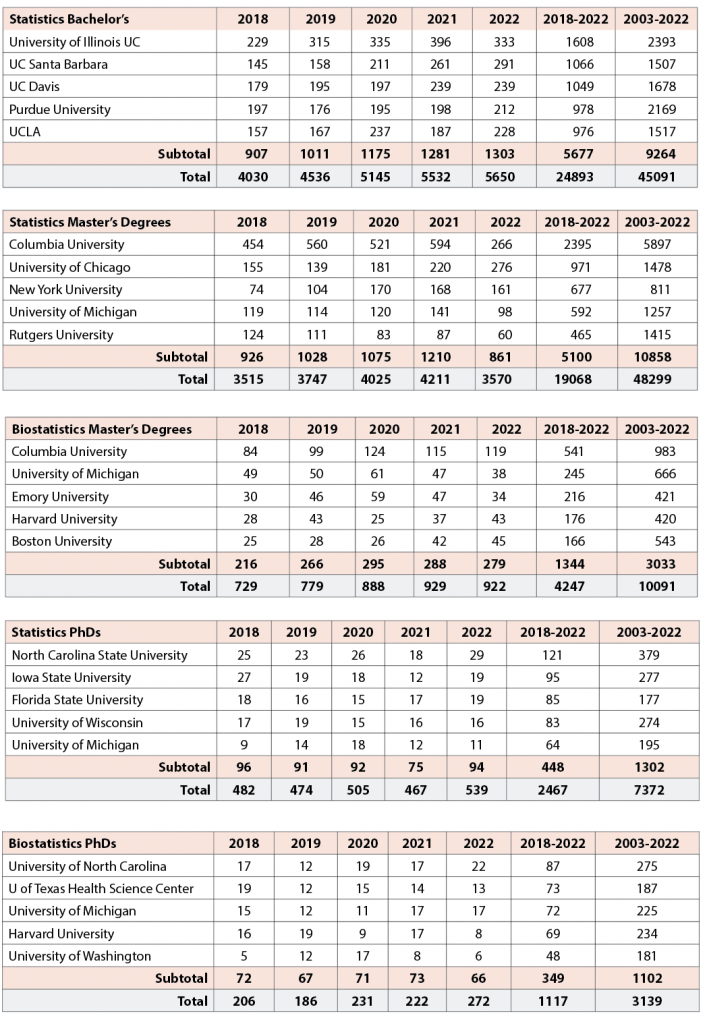

















Leave your response!